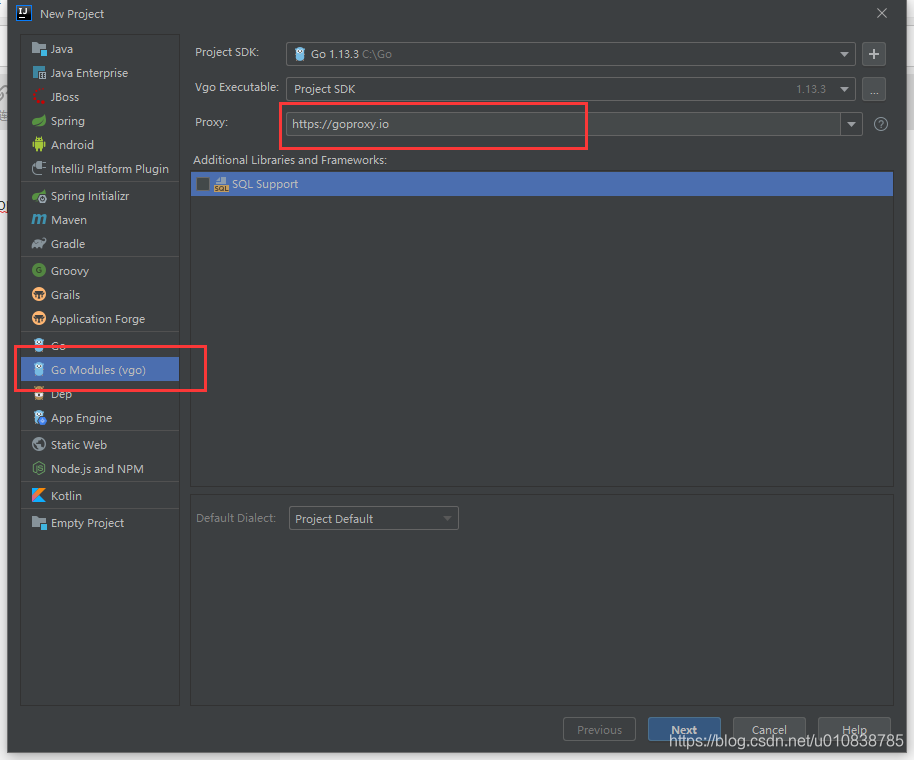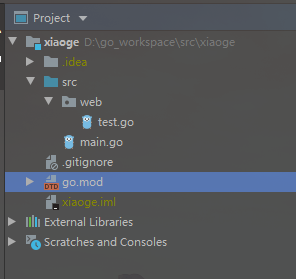1、ide:idea、goland
2、web框架:iris
3、idea设置:languages&frameworks→go→go modules→proxy:https://goproxy.io
4、"https://goproxy.io"通过设置代理 下载依赖会特别迅速
创建项目

项目创建完成的目录结构

main.go
package main
import (
"github.com/kataras/iris"
"github.com/kataras/iris/middleware/logger"
"github.com/kataras/iris/middleware/recover"
"github.com/kataras/iris/mvc"
"xiaoge/src/web"
)
func main() {
app := iris.New()
//(可选)添加两个内置处理程序(handlers)
//可以从任何与 http 相关的恐慌(http-relative panics) 中恢复
//并将请求记录到终端。
app.Use(recover.New())
app.Use(logger.New())
// "/" 服务于一个基于根路由的控制器。
mvc.New(app).Handle(new(web.ExampleController))
// http://localhost:8080
// http://localhost:8080/ping
// http://localhost:8080/hello
// http://localhost:8080/custom_path
app.Run(iris.Addr(":8080"))
}
test.go controller
package web
import (
"github.com/kataras/iris"
"github.com/kataras/iris/mvc"
)
// ExampleController 服务于 "/", "/ping" and "/hello" 路由。
type ExampleController struct{}
// Get serves
// Method: GET
// Resource: http://localhost:8080
func (c *ExampleController) Get() mvc.Result {
return mvc.Response{
ContentType: "text/html",
Text: "<h1>Welcome</h1>",
}
}
// GetPing serves
// Method: GET
// Resource: http://localhost:8080/ping
func (c *ExampleController) GetPing() string {
return "pong"
}
// GetHello serves
// Method: GET
// Resource: http://localhost:8080/hello
func (c *ExampleController) GetHello() interface{} {
return map[string]string{"message": "Hello Iris!"}
}
// BeforeActivation 会被调用一次,在控制器适应主应用程序之前
// 并且当然也是在服务运行之前
// 在版本 9 之后,你还可以为特定控制器的方法添加自定义路由。
// 在这个控制器,你可以注册自定义方法的处理程序。
// 使用带有 `ca.Router` 的标准路由
// 在不适用 mvc 的情况下,你可以做任何你可以做的事情
// 并将添加的依赖项绑定到
// 一个控制器的字段或者方法函数的输入参数中。
func (c *ExampleController) BeforeActivation(b mvc.BeforeActivation) {
anyMiddlewareHere := func(ctx iris.Context) {
ctx.Application().Logger().Warnf("Inside /custom_path")
ctx.Next()
}
b.Handle(
"GET",
"/custom_path",
"CustomHandlerWithoutFollowingTheNamingGuide",
anyMiddlewareHere,
)
// 或者甚至可以添加基于这个控制器路由的全局中间件,
// 比如在这个例子里面的根路由 "/" :
// b.Router().Use(myMiddleware)
}
// CustomHandlerWithoutFollowingTheNamingGuide serves
// Method: GET
// Resource: http://localhost:8080/custom_path
func (c *ExampleController) CustomHandlerWithoutFollowingTheNamingGuide() string {
return "hello from the custom handler without following the naming guide"
}
// GetUserBy serves
// Method: GET
// Resource: http://localhost:8080/user/{username:string}
// By 是一个保留的“关键字”来告诉框架你要
// 在函数的输入参数中绑定路径参数,它也是
// 有助于在同一个控制器中拥有 "Get“ 和 "GetBy"。
//
// func (c *ExampleController) GetUserBy(username string) mvc.Result {
// return mvc.View{
// Name: "user/username.html",
// Data: username,
// }
// }
/*在一个控制器中可以使用多个 HTTP 方法,工厂会
为每条路由注册正确的 HTTP 方法,你可以按需取消注释:
func (c *ExampleController) Post() {}
func (c *ExampleController) Put() {}
func (c *ExampleController) Delete() {}
func (c *ExampleController) Connect() {}
func (c *ExampleController) Head() {}
func (c *ExampleController) Patch() {}
func (c *ExampleController) Options() {}
func (c *ExampleController) Trace() {}
func (c *ExampleController) All() {}
// 或者
func (c *ExampleController) Any() {}
func (c *ExampleController) BeforeActivation(b mvc.BeforeActivation) {
// 1 -> HTTP 方法
// 2 -> 路由路径
// 3 -> 控制器的方法名称应该是该路由的处理程序(handlers)。
b.Handle("GET", "/mypath/{param}", "DoIt", optionalMiddlewareHere...)
}
//激活后,所有依赖项都被设置 - 因此只能访问它们
//但仍可以添加自定义控制器或者简单的标准处理程序(handlers)。
func (c *ExampleController) AfterActivation(a mvc.AfterActivation) {}
*/
